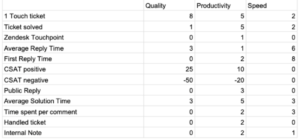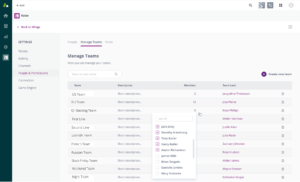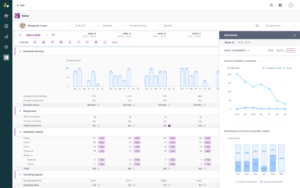Whether its a seasonal shift, product announcement, or a global crisis, chaotic peak periods with influxes of ticket volume are a reality that all support teams experience from time to time.
Whilst an increase in business is always positive, for customer support teams these high capacity periods can pose a number of operational issues. Perhaps the greatest hurdle for most teams in this scenario is providing a high level of service for a rapidly growing customer base whilst also tackling growing backlogs.
Implications of ticket influx & backlogs
If handled incorrectly, continually expanding backlogs can have deeply negative repercussions for a company. Support teams who are unable to handle their backlogs will notice a significant decrease in customer satisfaction, loyalty, and retention and an increase in negative response rates (NRR) as customers who are left unanswered becoming increasingly annoyed and despondent.
To avoid these situations, support managers are using strategies such as turning off real-time channels for a day to focus on the backlog or simply pruning ‘unsavable’ tickets from the end of their queues. Although these are great ideas to handle the influx, they are still reactive rather than proactive.
To ensure they are ahead of the curve, many industry-leading customer support teams are using Kaizo to shift towards proactively incentivizing quality and efficiency and disincentivizing chaotic, speed-focused crisis management.
Kaizo’s answer to fighting backlog & improving service levels
When it comes to dealing with ticket influx and backlog, many support teams immediately focus on improving speed-related metrics such as average handle time. The logic being that the faster you answer new and backlogged tickets, the less aggravated the customer will be.
.
The way we see it at Kaizo, whilst responding and speed are important, what is more important when dealing with influx and backlog is high quality, one-touch resolutions.
.
A focus on merely responding as quickly as possible can lead your support agents to lower their quality standards and use techniques like standardized macros to simply reduce customers’ wait time. This can lead to an increase in ticket re-open rates and end up costing your team more time and effort than simply answering tickets to a high standard initially.
Kaizo actively guides support agents & managers in real-time with point-based incentivization to:
- Improve one-touch resolution rates
- Avoid cherry-picking and focus on backlog prioritization
- Create specified teams & goals to tackle backlog
- Provide real-time insights to close performance gaps
How industry-leading teams are using Kaizo
Kaizo uses a unique form of gamification to help you proactively steer your team to provide a high level of service in peak periods and stay on top of backlogs. To do so, each agent is allocated a ninja avatar that collects skill points to mirror their successful or unsuccessful actions based on speed, quality, and productivity. E.g: 10 quality points for each one-touch solution.
Support managers can customize the game engine to allocate more points for areas that align with current company goals and KPIs and less for those that don’t. This point-based incentivization helps you guide your team towards achieving a higher level of service at all times.
Incentivizing first-touch responses
A common issue for support teams when it comes to time-sensitive, high volume periods is ensuring that your level of service provided is still at a high level of quality. For many teams the pressure of answering an influx of tickets encourages agents to focus on the speed of responding to tickets, leaving the quality of resolving tickets at the wayside.
Kaizo’s game engine allows managers to customize criteria to dictate what actions agents are rewarded with in-game skill points. To ensure agents provide a high level of quality for incoming and backlogged tickets, you can allocate an increased amount of points for one-touch solutions and set negative points for any ticket reopens. E.g – setting the game engine to allocate 50+ quality points for one-touch solutions and -20 quality points for ticket reopens.
This allows you to actionably motivate and incentivize your agents to not only provide a consistently high level of service but also save drastically on time and resources otherwise spent on multi-touch tickets.
Minimizing cherrypicking
It’s no secret that when your support team has an extensive backlog, the customers waiting for a response at the back of the queue are often the angriest and hardest to deal with. This raises an issue for many support teams as agents avoid answering these undesirable tickets and merely ‘cherrypick’ newer, more desirable tickets, leaving the older tickets unanswered.
.
“Using elements of gamification [skill points] helps not only diffuse the stress of a massive backlog but incentivizes agents to tackle it head-on. It can turn it from a dreaded task into a friendly competition”
Jan Brenneke, Chief Supply Officer at Talixo
.
Similarly, to incentivizing one-touch solutions, with Kaizo managers can customize their game engine to allocate more points to agents that answer older, backlogged tickets. On top of this, in periods when backlog should be prioritized, you can reduce point allocation for speed-based metrics like average reply time. This ensures agents aren’t simply trying to burn through their backlog as quickly as possible.
This allows teams to actively prioritize incoming and existing tickets and ensure that an even distribution of tickets are answered efficiently and to a high standard. The incentivization also minimizes the number of customers lost due to unanswered tickets and increase the satisfaction of inbound customers.
Creating strategic backlog teams
Like any time-sensitive issue, tackling a growing backlog can often be a hard operation to organize. Managers need to make strategic decisions on whether they would like to slowly chip away at it and run the risk of losing customers at the end of the queue or shut down operations temporarily and tackle it full force with the risk of having unanswered real-time inquiries.
Kaizo’s team setting allows you to create performance teams within your existing group of employees. To tackle backlog, managers can create specific teams dedicated to answering old, unanswered tickets. Within this team, managers can customize the game engine point allocation and set specific goals, separate from other teams, focused on tackling backlog tickets.
This allows you to harness focus on critical backlog issues and motivate agents to tackle these older tickets when they otherwise would have avoided them. This incentivization and focus is a sure-fire strategy to increase your team’s productivity and output quality.
Closing performance gaps
When support teams start getting out of their depth with inbound inquiries it is important to take a step back from the chaos and analyze the team’s performance to see where they need to improve. This is often a very time-consuming and inaccurate process for managers as they sift through manually entered historic data to try and decipher where the team’s performance is lacking.
Kaizo’s Scorecard provides an automated real-time overview of each agent’s performance with 50+ metrics and the ability to drill in to each of these metrics to see what caused the success or failure of an agent’s performance. You can also see side by side comparisons of agent/team performance and completion of their goals in the Arena.
.
“The scorecard allows me to see how my agents are operating in real-time and at such a granular level. I use the incident drill in and heatmap features to pinpoint areas for improvement, making it a lot easier and efficient to manage my team’s performance”
Darren Reeves, Support Team Lead at Resolver
.
These insights allow you to easily identify outliers and issues with workflows and develop constructive feedback. Hence, you more educated on where to efficiently use your resources to ensure you continue to provide high-quality service in peak periods.







